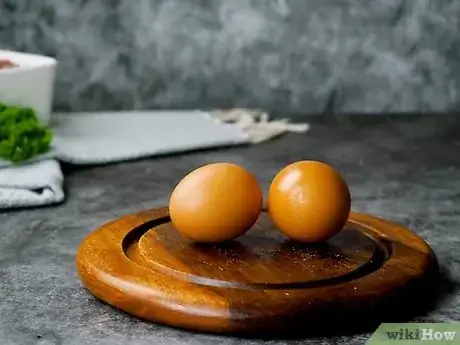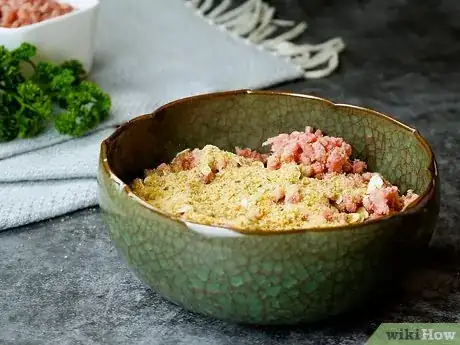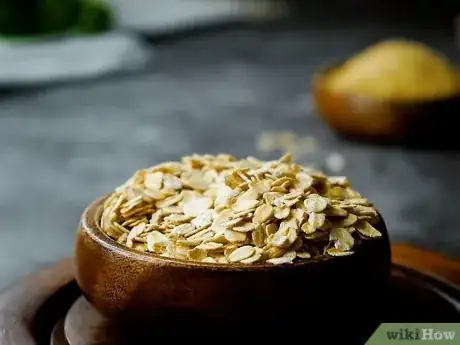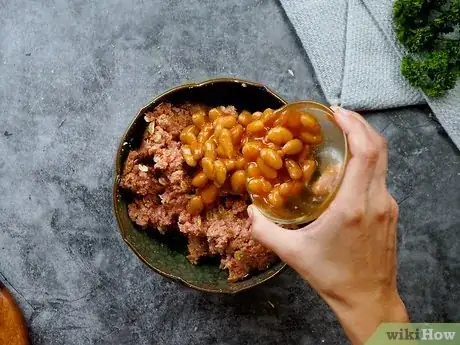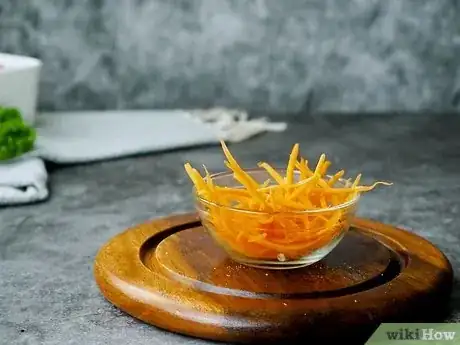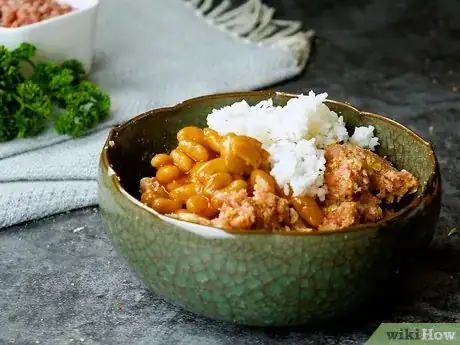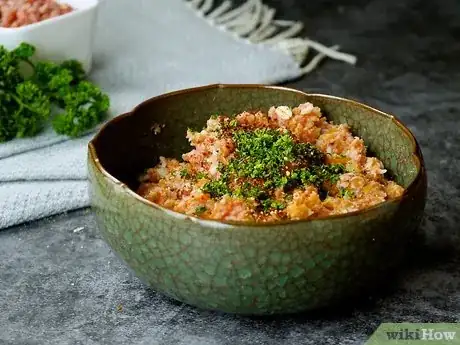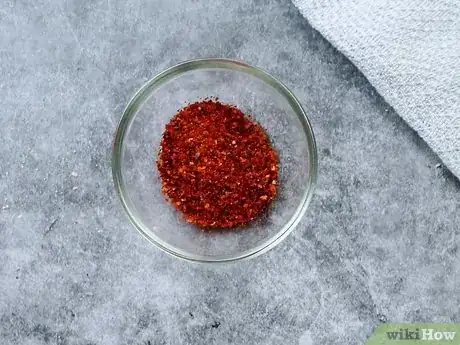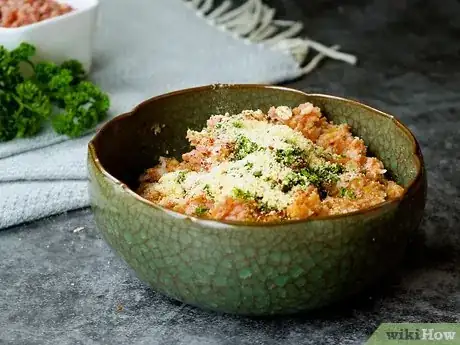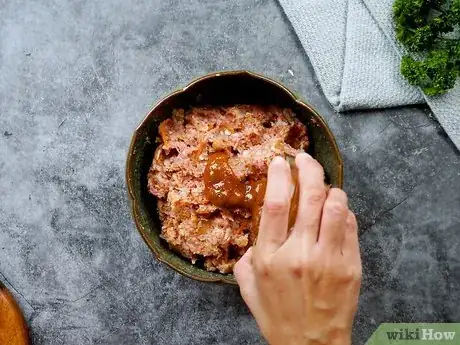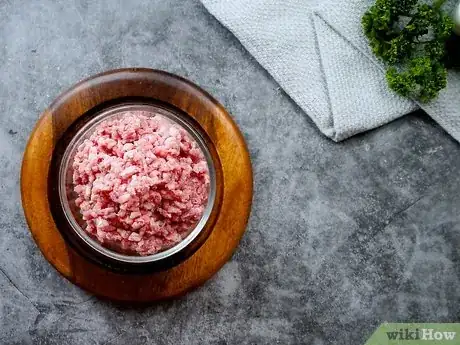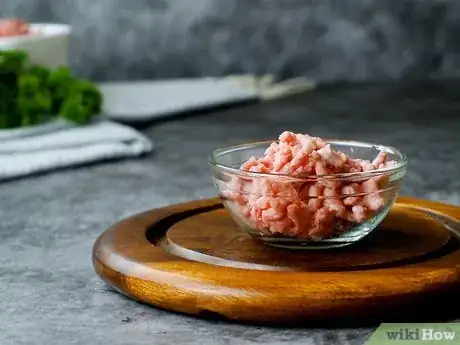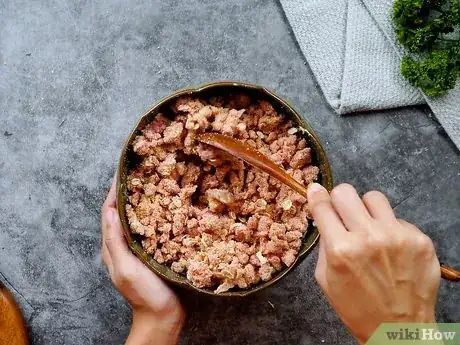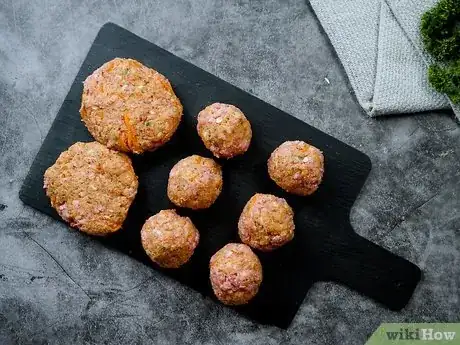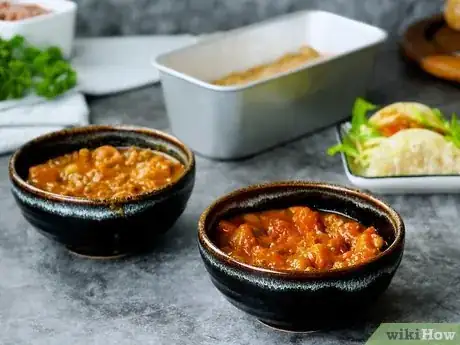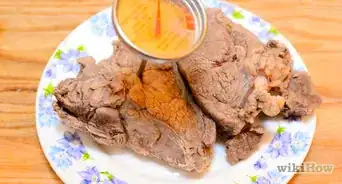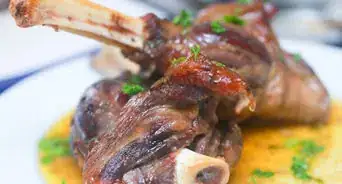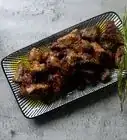This article was co-authored by wikiHow Staff. Our trained team of editors and researchers validate articles for accuracy and comprehensiveness. wikiHow's Content Management Team carefully monitors the work from our editorial staff to ensure that each article is backed by trusted research and meets our high quality standards.
The wikiHow Culinary Team also followed the article's instructions and verified that they work.
This article has been viewed 22,260 times.
Learn more...
With the rising costs of beef and health concerns over eating too much red meat, there are plenty of reasons to try to do more with less ground beef. Stretching ground beef in your favorite recipes can not only help you save money, but can make the dishes a little leaner and healthier too. While you can cut down on the amount of ground beef that you use in most recipes, it's usually best to mix extenders, such as breadcrumbs, rice, or grated veggies, into the beef so it goes further. Most extenders won't alter the taste or texture of the beef too much, but you do need to handle it a little differently than regular ground beef if you want the tastiest burgers, meatloaf, and meatballs possible.
Steps
Adding Extenders to the Ground Beef
-
1Use eggs as a binder with dry extenders. There are a variety of foods that you can mix in with ground beef to help stretch it. However, dry extenders, such as breadcrumbs and oats, require some type of binder to help hold the mixture together for burgers, loafs, or balls. Eggs are an ideal option because their proteins can easily hold the meat mixture together when heated.[1]
- As a general guideline, use 1 egg for every ½ pound (227 g) of ground beef that you’re mixing an additive into in order to stretch it.
- You can use egg substitute in place of the egg if you prefer.
- You can also replace every whole egg with two egg whites if you prefer.
-
2Mix in breadcrumbs. One of the most common extender for stretching ground beef is breadcrumbs. They work especially well in meatballs and meatloaf, but you may enjoy them in burgers as well.[2]
- Some recipes call for mixing equal amounts of breadcrumbs and ground beef when trying to stretch the meat. However, that may alter the texture more than you’d like. Start with a smaller amount and only add more if you need to stretch the beef further.
- White breadcrumbs work fine for stretching ground beef, but wholewheat breadcrumbs are usually a better option.
Advertisement -
3Work some oats into the beef. Just like breadcrumbs, whole or rolled oats can help stretch ground beef a little further in your favorite recipe. They mix easily in with the beef and won’t be noticed once you cook the meat. Best of all, the oats are high in fiber so they can help make your meal more filling.[3]
- In general, use ¼ to ½ cup (23 to 46 g) whole or rolled oats for every pound (454 g) of ground beef.
- To stretch ground beef in dishes such as tacos, chili, casseroles, and pasta sauces, you can also substitute bulgur wheat, which is a type of whole wheat. A cup (250 g) of cooked bulgar wheat can replace a pound (454 g) of ground beef, so if a recipe calls for two pounds (908 g) of browned ground beef, you can use 1 pound (454 g) of the beef and 1 cup (250 g) of the cooked bulgar wheat.[4]
-
4Include some beans. For tacos, chili, and casseroles, adding precooked beans to your ground beef can help stretch it. In particular, black and pinto beans mix well with the beef. Brown the beef first, though, and blot the excess grease before adding the beans.[5]
- In most recipes, you can mix an equal amount of beans and ground beef.
- If you aren’t a fan of beans, you can mix precooked lentils in with raw ground beef. When they are mixed, you can cook the mixture just as if it was regular ground beef. In general, use 1 cup (75 g) of cooked lentils for every pound (454 g) of meat.
-
5Stir in grated vegetables. Whether you’re making burgers, meatloaf, or meatballs, mixing some grated vegetables in with the ground beef can make it go further. Grate carrots, zucchini, and onions and mix them in with the raw beef before shaping it.[6]
- As a general rule, add ¾ to 1 cup (40 to 50 g) of grated vegetables for every pound (454 g) of ground beef.
- Mushrooms also make a good mix in with ground beef, but you should saute them first so they release their liquid and don’t add too much moisture to the meat.
- Caramelizing onions before you add them to the ground beef can help add rich flavor to burgers, meatloaf, or meatballs.
- Other firm root vegetables, such as beets and parsnips, also work well as an extender for ground beef.
- It may seem strange, but fruit can be a tasty contender for ground beef. Mix crushed pineapple into meatballs, finely chopped blueberries into burgers, or peeled and shredded Granny Smith apples into meatloaf.
-
6Combine the beef with rice. If you’re making tacos, chili, or sloppy Joes, you can mix some cooked rice into the beef to help extend it. Brown the meat as you normally would and drain the excess grease before mixing in the rice.[7]
- As a rule of thumb, add 1 cup (250 g) of cooked rice for every pound (454g ) of ground beef.
- Both white and brown rice work well as an extender for ground beef.
Using Seasonings to Boost the Flavor
-
1Mix fresh herbs into the dish. Fresh herbs have a bright taste that can help balance any flavor that might be lost by cutting back on the meat. Add finely chopped fresh herbs such as basil or parsley to the ground beef before you cook it or form it into burgers, meatloaf, or meatballs.[8]
- Basil, parsley, and cilantro can work well for burgers.
- Basil, parsley, rosemary, thyme, oregano, and sage can work well for meatloaf.
- Basil, parsley, rosemary, thyme, and oregano can work well for meatballs.
-
2Use bold dried herbs and spices to season the dish. The right spices and dried herbs can also help make up for any flavor that might be lost if you cut back on the ground beef. Season the raw ground beef with spices and dried herbs, such as crushed red pepper or marjoram, before forming it into burgers, meatloaf, or meatballs.[9]
- Crushed red pepper, cayenne pepper, garlic powder, onion powder, and steak seasoning can work well for burgers.
- Crushed red pepper, cayenne pepper, garlic powder, onion powder, steak seasoning, dried oregano, and dried basil can work well for meatloaf.
- Crushed red pepper, garlic powder, onion powder, dried oregano, and dried basil can work well for meatballs.
-
3Add hard cheeses to the dish. Mixing some grated hard cheese into the ground beef before you form the burgers, meatballs, or meatloaf can help boost the flavor so you don’t notice that there’s less meat. Parmigiano-Reggiano and pecorino Romano are both ideal options.[10]
- Parmigiano-Reggiano and pecorino Romano are obviously ideal for mixing into ground beef that you plan to make into meatballs, but you can also use them for burger or meatloaf mixes.
-
4Incorporate sauces and condiments in the dishes. Mixing a little sauce or your favorite condiment into raw ground beef before you make your burgers, meatballs, or meatloaf can help make up for any missing flavor from the decrease in meat. For example, add some ketchup, thick pasta sauce, whole-grain mustard, barbecue sauce, or thai curry paste to your ground beef mixture.[11]
- Be careful not to add too much of the sauce or condiment. Excess moisture can lead to mushy burgers, meatloaf, and meatballs. Using 1 to 2 tablespoons (15 to 30 ml) for every pound (454 g) of meat is a good rule of thumb.
Choosing and Handling the Ground Beef
-
1Opt for a leaner grind. If you’re trying to stretch ground beef to make your meals a little healthier, it’s best to start with a leaner cut of ground beef. While fatty cuts tend to be juicier, leaner cuts are lower in saturated fat and calories so you don’t have to feel as bad about using them in your recipes.[12]
- Ground sirloin and ground round are usually the leanest cuts of ground beef that you can get. Ground sirloin has 10 to 14% fat, while ground round has about 12% fat.
- Avoid regular ground beef, which usually has 25 to 30% fat.
-
2Use less ground beef. It may seem pretty obvious, but the easiest way to stretch your ground beef is just use less of it. If a recipe calls for 2 pounds (908 g) of ground beef, cut it down to 1 ½ pounds (680 g). In most cases, you won’t even notice the difference.[13]
- If you’re worried that your dish will be lacking, trying mixing in more of other ingredients, such as vegetables or starches, to make up for the ground beef that you’ve cut.
- If you’re making burgers, meatloaf, or meatballs, shape your patties, loaf, or balls slightly smaller than usual so you don’t need as much ground beef.
-
3Avoid over mixing the beef. Whether you’re adding an extender, binder, or spices and seasonings into raw ground beef, be careful not to overmix it. Mixing it too much can lead to tough burgers, meatloaf, or meatballs. Use clean hands to gently mix the beef and other ingredients until they’re just combined.[14]
-
4Shape and turn the beef gently. When you’ve added extenders or other ingredients to the ground beef, the mixture is usually more fragile than straight ground beef. Lightly pat the meat mixture to form the burgers, loaf, or meatballs, and gently flip the burgers and meatballs with a spatula to avoid breaking them.[15]
- When you’re shaping the meat mixture, do not pack the burgers or meatballs together too tightly or they may crumble.
- Spoon a ground beef mixture for meatloaf into the pan without packing it too tightly against the sides.
-
5Finished.
References
- ↑ http://www.oregonlive.com/foodday/index.ssf/2012/05/keep_the_comfort_but_cut_the_f.html
- ↑ http://www.oregonlive.com/foodday/index.ssf/2012/05/keep_the_comfort_but_cut_the_f.html
- ↑ http://www.gracefullittlehoneybee.com/how-to-stretch-ground-beef-using-oats/
- ↑ http://thriftyjinxy.com/how-to-substitute-bulgur-wheat-for-ground-beef-in-your-recipes-save-money-be-healthy/
- ↑ http://www.sparkpeople.com/blog/blog.asp?post=calorie_savers_the_meat_edition
- ↑ http://www.oregonlive.com/foodday/index.ssf/2012/05/keep_the_comfort_but_cut_the_f.html
- ↑ http://www.everydaycheapskate.com/food-and-recipes/making-high-cost-ground-beef-easier-swallow/
- ↑ http://www.oregonlive.com/foodday/index.ssf/2012/05/keep_the_comfort_but_cut_the_f.html
- ↑ http://www.oregonlive.com/foodday/index.ssf/2012/05/keep_the_comfort_but_cut_the_f.html
- ↑ http://www.oregonlive.com/foodday/index.ssf/2012/05/keep_the_comfort_but_cut_the_f.html
- ↑ http://www.oregonlive.com/foodday/index.ssf/2012/05/keep_the_comfort_but_cut_the_f.html
- ↑ http://www.oregonlive.com/foodday/index.ssf/2012/05/keep_the_comfort_but_cut_the_f.html
- ↑ http://eatwellspendsmart.com/how-to-stretch-meat-and-protein-to-save-money/
- ↑ http://www.oregonlive.com/foodday/index.ssf/2012/05/keep_the_comfort_but_cut_the_f.html
- ↑ http://www.oregonlive.com/foodday/index.ssf/2012/05/keep_the_comfort_but_cut_the_f.html
About This Article
If you’re trying to cut back on red meat but still want to make your favorite ground beef recipes, or if you just want to make better use of the ground beef you do have, there are several ways to stretch ground beef so a little goes a longer way. One of the most common ways to do this is by incorporating dry extenders like rolled oats or breadcrumbs. While these are good options for stretching ground beef, they may alter its texture slightly, so start by adding a small amount, and only use more if your ground beef still needs to stretch further. If you’re using oats to stretch the meat, a good rule of thumb is to use 1/4 to 1/2 cup (23 to 46 g) of whole or rolled oats for every 1 pound (454 g) of ground beef. If you’re using a dry extender in your beef, it’s also helpful to use a binder to hold the mixture together. Eggs or egg substitutes work well for this purpose and help oats and breadcrumbs bind to the ground beef so your burgers or meatballs hold their shape. In general, use 1 egg for every 1/2 pound (227 g) of ground beef you are stretching using dry extenders. You can also get creative and stretch your ground beef by mixing it with beans, rice, or grated veggies. Finally, to boost any flavor you might lose by using less meat in a recipe, make sure your stretched beef is still tasty by using sauces and spices, fresh herbs, or even some grated cheese to keep the meat flavorful. Use your stretched ground beef to make anything from a delicious meatloaf to tacos, casseroles, or chili.
